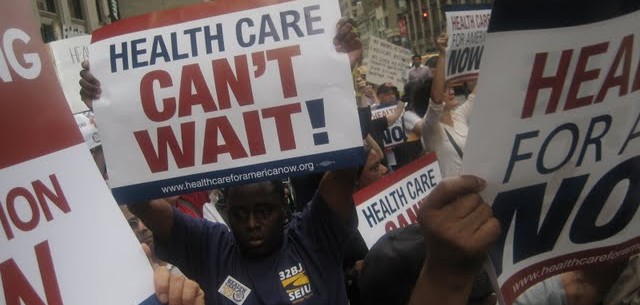Whoever would have imagined we’d be in the situations we find ourselves in now a mere six months ago? A global life-threatening viral pandemic (that is still intensifying), a severe economic recession (that is still worsening), and social uprisings against racial injustice (that are long overdue.) So far, it’s clearly been a year like no other that is challenging all of us to our very core.

Going Bold:
As 2020 began, health advocates from major coalitions had united behind a joint “Go Bold” agenda for the year’s legislative session. The groups involved were the Campaign for New York Health, Coverage for All, Health Care for All New York, and Medicaid Matters New York. (Metro New York Health Care for All belongs to all of them, and helps to lead three of them.) Our joint policy agenda included:
- Pushing the New York Health Act (S,3577/A.5248, Rivera/Gottfried) forward in the legislative process with an eye toward a) getting a floor vote in the Assembly, and b) getting it through the Committee process in the Senate and the number of co-sponsors to at least one-half of all members.
- Covering all immigrants by expanding New York’s very successful Essential Plan to all low-income immigrants, benefitting up to 110,000 people (S.3900/A.5974 (Rivera, Gottfried.)
- Making Affordable Care Act health plans more affordable by offering additional premium subsidies through the state budget, and opening up the Essential Plan for people to buy into. Augmenting this focus is additional funding for community-based outreach and enrollment programs through the state budget.
- Preventing cutbacks to Medicaid, and instead funding it fully by raising taxes slightly on the ultra-rich in a number of ways as proposed by the New York Budget Justice campaign.
- Raising new, additional revenue to fully-fund all health and human service needs by requiring ultra-wealthy New Yorkers to once again pay their fair share of taxes after decades of tax cuts they have benefitted from at both the state and federal level.

Defending Medicaid:
When Gov. Cuomo announced his budget proposals in mid-January, he said the budget gap was around $6B (billion), and attributed around $4B of it to a “Medicaid deficit”, particularly in the area of cost growth for long-term care (nursing homes, home health care and personal care.) He especially pointed to growth of the state’s very successful Consumer-Directed Personal Assistance Program (CDPAP) that allows people to stay in their homes and live in their communities as opposed to having to enter very expensive nursing homes.
It is important to understand that the state’s so-called Medicaid deficit exists only in relation to an arbitrary “global cap” that Gov. Cuomo and the State Legislature imposed on annual Medicaid spending and growth back in 2012. Otherwise, this year it has no other reality other than as a reflection that demand for long-term care has grown as the population has aged and the price of those services has gone up, particularly for personnel given recent raises in the minimum wage. Since the cap was imposed, Medicaid spending has grown 3-4% on average year-to-year. Advocates characterize the use of this cap as a defacto “block granting” of the program, a step Gov. Cuomo has always decried whenever similar moves were proposed (but never adopted) by Congress.
Further exacerbating the situation, Gov. Cuomo has always imposed an overall spending growth cap of 2% on the state budget as a whole, and the Legislature has never challenged him over that. The sum total of these steps, along with other types of spending caps he’s used, has been to put the state on an austerity budget footing throughout his entire tenure, something that he has insisted on. Complicating this situation is a State Court of Appeals ruling from the early 2000s (Silver v. Pataki) that affirmed a Governor’s supremacy over the state budget in relation to the Legislature.
Rather than lay out any specific cuts to Medicaid in his proposed budget that he released in mid-January, Gov. Cuomo simply entered a line item number of $4B in “savings” to be achieved by a) $1.5B from Medicaid cost-shifts onto local governments ($1B of which would fall onto New York City and our public hospital system in particular) based on long-term care utilization growth, and b) $2.5B in program changes to be developed by a “Medicaid Redesign Team” (MRT), an unusual mechanism he used when he first took office in 2011 to curtail Medicaid spending in the wake of the Great Recession. When its membership was announced in early February, it was comprised of 21 members, almost all of whom were representatives of various industry stakeholders and members of Cuomo administration. Sadly, only one (token) consumer/community representative was included to represent the diverse populations who rely on Medicaid, T.K. Small from Concepts of Independence.
An ad-hoc campaign dubbed “Protect Medicaid” was quickly formed by a number of statewide health advocacy groups including the Campaign for NY Health, Child Health Now, Consumer-Directed Personal Assistance Association of NYS, Health Care for All NY, Medicaid Matters NY, NY Association on Independent Living, NY Statewide Senior Action Council, and Save NY Public Health. We played a key role in leading this campaign which focused on keeping the state’s broader health and social service advocacy community aware of the MRT process, coordinating efforts to influence the MRT’s deliberations, engaging legislators on the issues in play, and calling the media’s attention to what was at stake for people who rely on Medicaid.
In the end, the MRT process proved to be very rushed and perfunctory with some public engagement mechanisms that proved little more than window dressing for ideas that the Cuomo administration had already developed and just wanted rubber stamped. These proposals were then taken into the final budget negotiations with the State Legislature at the very last minute, a highly unusual procedure given how significant the Medicaid portion of the overall budget really is, and was done in a way that up to that point had completely cut the Legislature out of the process of reviewing and developing a Medicaid budget. $2.2B in cuts were made, including very significant changes to long-term care programs to limit eligibility and curtail the recruitment and retention of home care workers.
The final budget deal was concluded just as the COVID-19 pandemic was hitting our state full force. In fact, during the last two weeks in March, much legislative activity moved online and the final agreement was almost exclusively negotiated between Gov. Cuomo, Senate Majority Leader Andrea Stewart-Cousins, and Assembly Speaker Carl Heastie, with little if any involvement of major committee chairs nor rank-and-file members. In addition, there were no one-house bills passed nor the usual (largely ceremonial) conference committee process invoked, both standard parts of a normal year’s budget process.

Other Aspects of the Final Budget:
- The shift of some Medicaid costs for excess long-term care costs onto the counties was not approved. Instead, a portion of counties sales taxes will be held by the state and dedicated to support safety net hospitals.
- Pharmacy coverage for people enrolled in Medicaid managed care plans will be removed from private insurers, and instead will be provided through the state’s existing program for fee-for-service Medicaid where it negotiates lower prices with drug manufacturers.
- Concerning expansions of existing coverage programs, a new state-funded premium subsidy for Affordable Care Act private insurance plans offered on the state’s New York State of Health online marketplace was not created. In addition, opening up the state’s Essential Plan to all immigrants was not improved.
- Funding for New York’s health insurance consumer assistance program was preserved, but was not increased. Unfortunately, no new funding for community-based outreach programs was created.
- On the positive side, some consumer protections against medical debt were strengthened, the distribution of charity care funds to hospitals was improved to better target safety net providers who serve large numbers of Medicaid and uninsured patients, and a new prescription drug affordability board was created to moderate drug prices for those not on public insurance programs.
- Insurers can no longer charge insulin-dependent people with diabetes co-payments higher than $100/month per prescription.
- Gov. Cuomo was granted special power to propose periodic budget cuts at the end of April, June, and December. They would go into effect in 10 days after announcement unless the Legislature enacts a different set of cuts.

The Fight for More Revenue:
Since Gov. Cuomo took office nearly a decade ago, he has consistently pursued conservative fiscal policies to limit any new taxes, cut taxes whenever possible, and curtail spending growth to very modest levels. The result has been that existing health care and social programs have either been outright cut or not allowed to grow to meet need, possible new ideas and programs were not developed despite their merits, and state agencies have been unable to hire new staff to carry out proper oversight and implementation roles.
With the change in the balance of power in the State Legislature last year as progressive political forces gained ascendancy, there was much optimism that the state could and would finally turn a corner away from Gov. Cuomo’s longtime politics of austerity, and some health and human service advocates came together under the “New Hope for New York” campaign. However, change did not happen then because the new Senate Majority was not able to coalesce effectively behind an alternative to his stance.
Starting last fall, a much broader array of social justice and politically progressive activist groups and unions joined forces to form the New York Budget Justice campaign, led jointly by Empire State Indivisible, Fiscal Policy Institute, and Strong Economy for All. The campaign undertook a variety of strategies and tactics since the start of this year to promote the overall call for raising new revenues by slightly raising taxes on ultra-wealthy New Yorkers, and developed more than a dozen different tax proposals (www.nybudgetjustice.com/initiatives.)
While Gov. Cuomo opposed these ideas, support began to grow within the Legislature, and bills were introduced. Unfortunately, when the COVID-19 pandemic hit our state full force in mid-March, the usual budget process immediately ground to a halt, everything went behind closed doors for a fast wrap-up, and the whole “new revenue” effort stalled out. However, the campaign continues to live on and is significantly building steam since then. Depending on how the budget adjustment process plays out over the course of this year, there may be new legislative opportunities that arise.
